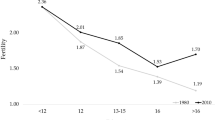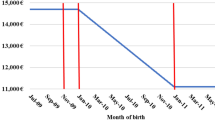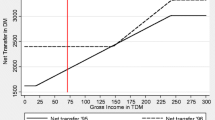Abstract
We examine the long-run effects of the pay-as-you-go (PAYG) social security scheme on fertility and welfare of individuals in an overlapping generations model, assuming that child-care services are available in the market. We show that the impact of a tax increase on fertility depends on the relative magnitudes of the standard intergenerational redistribution effect through the social security system, the (implicit) subsidy effect through tax-exemption of child rearing at home, and the price effect through changes in the relative price of market child care, and that if parental child-rearing time is inelastic, a tax cut could bring about a Pareto-improving allocation.

Similar content being viewed by others
Notes
Kögel (2004) casts doubt on the positive relationship because of possibly unmeasured factors specific to each country.
We assume that the capital/labor ratio is greater than the foreign debt per worker in the steady state.
The child care outside the home here could be day nurseries/preschools and day-care centers (the so-called organized child care) as well as services of baby-sitters at a child’s home, as suggested in Becker (1965).
As our focus is on the effects of social security on fertility choice in cases where child care services outside the home are available, we employ the Cobb–Douglas specification for the function, which is suggested as an example in Apps and Rees (2004).
We may assume instead that market child care is produced by employing market labor as well as market goods. Even if market child care is produced in a more labor intensive technology, the price effect of fertility with respect to a tax will not be reversed. See Appendix A. In contrast, Martinez and Iza (2004), assuming unskilled child-care services outside the home, showed that the increases in female mean wages could generate the positive relationship between fertility rates and female labor force participation rates, which was observed in the USA during the last two decades. However, we assume away heterogeneity of parents in this paper.
Defining the cost of child rearing as \( C_{t} = {\left( {1 - \tau } \right)}wz_{t} + x_{t} \), we have \( C_{t} = \frac{1} {{\theta \beta }}{\left( {\frac{\beta } {{1 - \beta }}{\left( {1 - \tau } \right)}w} \right)}^{{1 - \beta }} n_{t} = pn_{t} \).
Breyer and Straub (1993) assumed the perfect foresight of individuals into the next generation’s labor supply.
The fertility rate when τ = 0, equal to \( \frac{\gamma } {{1 + \gamma + \rho }}\frac{w} {p} \), may be greater than, equal to, or smaller than the world rate of interest.
The intercept of the curve ZZ with the vertical axis moves upward with a tax increase when n ≥ r, while it may shift downward when n < r.
Appendix C gives a numerical example for a set of plausible parameter values.
It should be noted that the positive relationship between the tax rate and the benefit level occurs at the time of policy change. It is natural to assume that a tax increase leads to an increase in tax revenue over the long run, too.
Further details are available from the authors upon request.
References
Ahn N, Mira P (2002) A note on the changing relationship between fertility and female employment rates in developed countries. J Popul Econ 15:667–682
Apps P, Rees R (2004) Fertility, taxation and family policy. Scand J Econ 106:745–763
Balestrino A, Cigno A, Pettini A (2002) Endogenous fertility and the design of family taxation. Int Tax Public Financ 9:175–193
Balestrino A, Cigno A, Pettini A (2003) Doing wonders with an egg: optimal re-distribution when households differ in market and non-market abilities. J Public Econ Theory 5:479–498
Becker GS (1965) A theory of the allocation of time. Econ J 75:493–517
Blau D, Robins PK (1988) Child-care costs and family labor supply. Rev Econ Stat 70:374–381
Breyer F (1989) On the intergenerational Pareto efficiency of pay-as-you-go financed pension systems. J Inst Theor Econ 145:643–658
Breyer F, Straub M (1993) Welfare effects of unfunded pension systems when labor supply is endogenous. J Public Econ 50:77–91
Cigno A (1993) Intergenerational transfers without altruism: family, market and state. Eur J Polit Econ 9:505–518
Eckstein Z, Wolpin KI (1985) Endogenous fertility and optimal population size. J Public Econ 27:93–106
Galor O, Weil DN (1996) The gender gap, fertility and growth. Am Econ Rev 86:374–387
Groezen B van, Leers T, Meijdam L (2003) Social security and endogenous fertility: pensions and child allowances as Siamese twins. J Public Econ 87:233–251
Kögel T (2004) Did the association between fertility and female employment within OECD countries really change its sign? J Popul Econ 17:45–65
Martinez DF, Iza A (2004) Skill premium effects on fertility and female labor force supply. J Popul Econ 17:1–16
Rindfuss R, Guzzo KB, Morgan SP (2003) The changing institutional context of low fertility. Popul Res Policy Rev 22:411–438
Sinn HW (1998) The pay-as-you-go pension system as fertility insurance and an enforcement device. J Public Econ 88:1335–1357
Yakita A (2001) Uncertain lifetime, fertility and social security. J Popul Econ 14:635–640
Zhang J, Zhang J, Lee R (2001) Mortality decline and long-run economic growth. J Public Econ 80:485–507
Acknowledgments
The authors wish to thank Murray C. Kemp and seminar participants at the Nagoya Macroeconomics Workshop for their comments. They are also indebted to two anonymous referees and to the editor, Alessandro Cigno, for their helpful comments and suggestions. This research is financially supported by the Postal Life Insurance Foundation of Japan. The second author also acknowledges financial support from the Japan Society for the Promotion of Science (Grant no. 18530127).
Author information
Authors and Affiliations
Corresponding author
Additional information
Responsible editor: Alessandro Cigno
Appendices
Appendix A
1.1 Market child care produced with labor and goods
Assume that the production function of market child care is written as
where m t is market goods purchased and l xt is labor employed, and that individuals decide how much market child care is produced by employing goods and labor. The budget constraint becomes
where m t + wl xt is the spending for the market child care. Labor of individuals, 1 − z t , is employed either in production of market child care, l xt , or in goods production, 1 − z t − l xt . The wage rates in both production sectors are the same by arbitrage. Assuming that Eq. 2 holds as in the text, the optimal demand plans are obtained in a similar way as in the text:
Making use of the budget equation, we have
In this case, defining the cost of child rearing as
we have
from which we obtain \( {dp} \mathord{\left/ {\vphantom {{dp} {d\tau }}} \right. \kern-\nulldelimiterspace} {d\tau } = { - p{\left( {1 - \beta } \right)}} \mathord{\left/ {\vphantom {{ - p{\left( {1 - \beta } \right)}} {{\left( {1 - \tau } \right)} < 0}}} \right. \kern-\nulldelimiterspace} {{\left( {1 - \tau } \right)} < 0} \). Therefore, assuming labor as well as goods as inputs in the market-child-care production does not alter our result essentially.
Appendix B
1.1 Derivation of dynamic equation (Eq. 16)
Combining Eqs. 14 and 15 (or Eqs. 10 and 12), we have
Substituting Eq. 37 into Eq. 14, we obtain
Dividing both sides of Eq. 38 by z t and rearranging them, we have the dynamic Eq. 16.
Appendix C
1.1 Numerical example
We show a numerical example, assuming parameter values of the model as follows: \( \beta = 0.3;\quad \theta = 30;\quad \gamma = 0.1;\quad \rho = 0.3{\left[ { \approx {\left( {1 + 0.05} \right)}^{{ - 24}} } \right]};\quad r = 2.033{\left[ { \approx {\left( {1 + 0.03} \right)}^{{24}} } \right]}; \) and w = 1.5.
One period is considered to consist of 25 years. These parameters are set so as to have the annual growth rate of population equal to about 1.5%, i.e., about 43% per period, at the tax rate of 20%. The steady state values of variables at various tax rates are presented in Table 2.
The results can be summarized as follows: (1) As Proposition 1 predicts, the child-rearing time is increasing with the tax rate; (2) at the tax rates from 0.05 to 0.35, as the condition of (2) of Proposition 2 holds, the fertility rate increases with the tax rate, but the purchases of the market child care decrease because of declining disposable income; (3) at even higher tax rates, as the tax-rate elasticity of child-rearing time becomes greater and the condition of (1) of Proposition 2 comes to be satisfied, the purchases of the market child care come to be increasing with the tax rate. In this situation, the market child care is purchased with the lowered disposable income. This reflects the fact that parents try to have many children to raise the social security benefits when retired; (4) as the weight on the utility from having children is relatively low in this example, the fertility rate rises with the tax increase.
The last column of Table 2 indicates the steady state welfare change at each tax rate. At the tax rates from 0.05 to 0.3, the tax increase diminishes the steady state welfare of individuals, while at the tax rates above 0.35 (up to 0.8, although this is not shown in the table), the tax increase improves the steady state welfare. It should be noted that the situation implied in the third column of Table 1 holds at tax rate 0.35.
Finally, to explain the mechanism of a Pareto improvement, we consider a tax cut of 0.01 from 82.5%. Suppose that the economy is initially at the steady state, then that the government cuts the tax rate by 0.01% in period 0. The time paths of the child-rearing time of individuals and the utility level of each generation are depicted in Fig. 2a,b, respectively. Although the initial tax rate is not plausible, we can see the mechanism of the Pareto improvement. As explained in the text, generation −1, retired in period 0, obtains a windfall of extra benefits because of the increased labor supply of generation 0.
The simulation analysis of this simple model does not generate plausible values of endogenous variables for the economy. It is partly because some other factors than those taken into account in this study affect the dynamics of the model. However, the conclusion of our study holds at least qualitatively.
Rights and permissions
About this article
Cite this article
Hirazawa, M., Yakita, A. Fertility, child care outside the home, and pay-as-you-go social security. J Popul Econ 22, 565–583 (2009). https://doi.org/10.1007/s00148-007-0153-8
Received:
Accepted:
Published:
Issue Date:
DOI: https://doi.org/10.1007/s00148-007-0153-8





